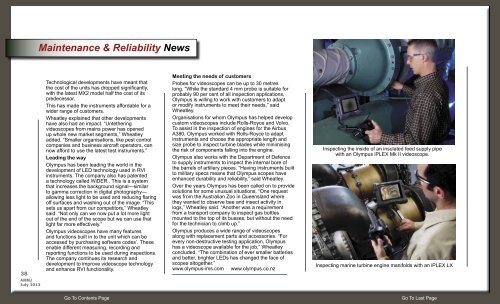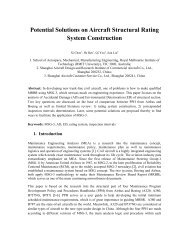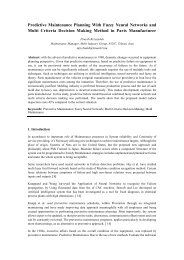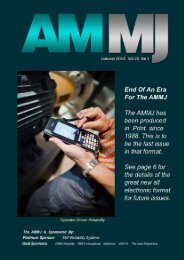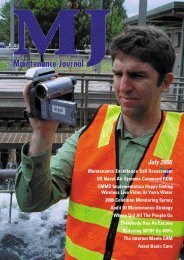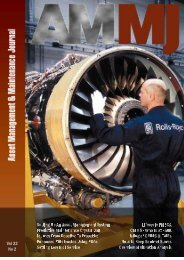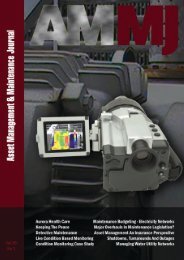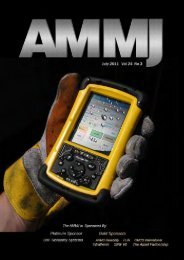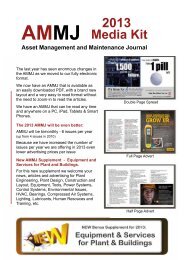Maintenance & Reliability News - Maintenance Journal
Maintenance & Reliability News - Maintenance Journal
Maintenance & Reliability News - Maintenance Journal
You also want an ePaper? Increase the reach of your titles
YUMPU automatically turns print PDFs into web optimized ePapers that Google loves.
<strong>Maintenance</strong> & <strong>Reliability</strong> <strong>News</strong><br />
38<br />
AMMJ<br />
October July 20132012<br />
Technological developments have meant that<br />
the cost of the units has dropped significantly,<br />
with the latest MX2 model half the cost of its<br />
predecessor.<br />
This has made the instruments affordable for a<br />
wider range of customers.<br />
Wheatley explained that other developments<br />
have also had an impact. “Untethering<br />
videoscopes from mains power has opened<br />
up whole new market segments,” Wheatley<br />
added. “Smaller organisations, like pest control<br />
companies and business aircraft operators, can<br />
now afford to use the latest test instruments.”<br />
Leading the way<br />
Olympus has been leading the world in the<br />
development of LED technology used in RVI<br />
instruments. The company also has patented<br />
a technology called WiDER . This is a system<br />
that increases the background signal—similar<br />
to gamma correction in digital photography—<br />
allowing less light to be used and reducing flaring<br />
off surfaces and washing out of the image. “This<br />
sets us apart from our competitors,” Wheatley<br />
said. “Not only can we now put a lot more light<br />
out of the end of the scope but we can use that<br />
light far more effectively.”<br />
Olympus videoscopes have many features<br />
and functions built in to the unit which can be<br />
accessed by purchasing software codes’. These<br />
enable different measuring, recording and<br />
reporting functions to be used during inspections.<br />
The company continues its research and<br />
development to improve videoscope technology<br />
and enhance RVI functionality.<br />
Meeting the needs of customers<br />
Probes for videoscopes can be up to 30 metres<br />
long. “While the standard 4 mm probe is suitable for<br />
probably 90 per cent of all inspection applications,<br />
Olympus is willing to work with customers to adapt<br />
or modify instruments to meet their needs,” said<br />
Wheatley.<br />
Organisations for whom Olympus has helped develop<br />
custom videoscopes include Rolls-Royce and Volvo.<br />
To assist in the inspection of engines for the Airbus<br />
A380, Olympus worked with Rolls-Royce to adapt<br />
instruments and choose the appropriate length and<br />
size probe to inspect turbine blades while minimising<br />
the risk of components falling into the engine.<br />
Olympus also works with the Department of Defence<br />
to supply instruments to inspect the internal bore of<br />
the barrels of artillery pieces. “Having instruments built<br />
to military specs means that Olympus scopes have<br />
enhanced durability and reliability,” said Wheatley.<br />
Over the years Olympus has been called on to provide<br />
solutions for some unusual situations. “One request<br />
was from the Australian Zoo in Queensland where<br />
they wanted to observe bee and insect activity in<br />
logs,” Wheatley said. “Another was a requirement<br />
from a transport company to inspect gas bottles<br />
mounted to the top of its busses, but without the need<br />
for the technician to climb up.”<br />
Olympus produces a wide range of videoscopes<br />
along with replacement parts and accessories. “For<br />
every non-destructive testing application, Olympus<br />
has a videoscope available for the job,” Wheatley<br />
concluded. “The combination of ever smaller batteries<br />
and better, brighter LEDs has changed the face of<br />
scopes altogether.”<br />
www.olympus-ims.com www.olympus.co.nz<br />
Inspecting the inside of an insulated feed supply pipe<br />
with an Olympus iPLEX Mk II videoscope.<br />
Inspecting marine turbine engine manifolds with an iPLEX LX<br />
Go To Contents Page<br />
Go To Last Page


